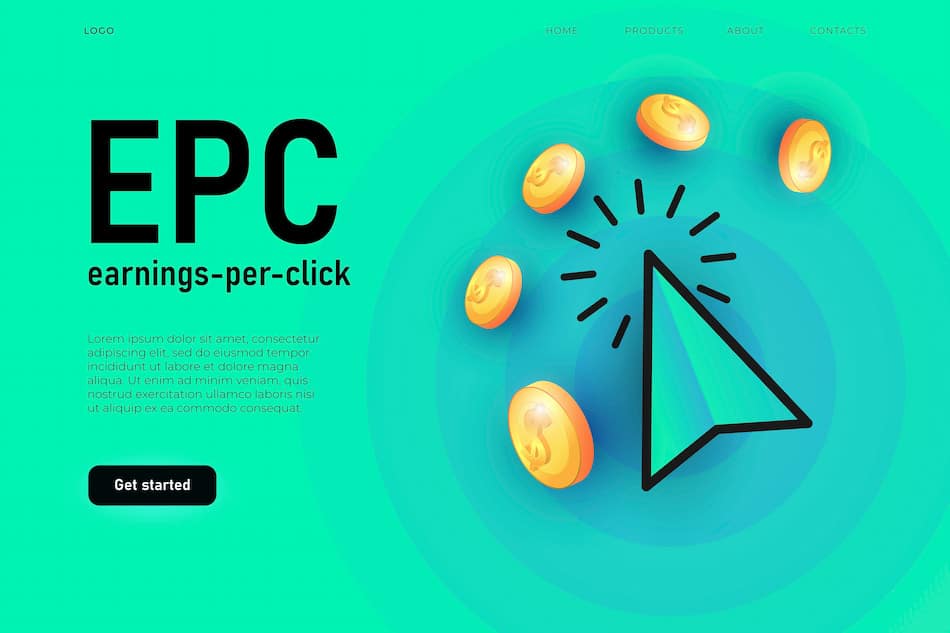If you’re an affiliate marketer trying to learn about earnings per click, you’ve come to the right place.
So, what is “earnings per click?” exactly, and why is everyone always talking about it?
Oh, it’s only THE metric that affiliate marketers use to figure out how well their campaigns are performing!
In this post, we’ll dive into the concept of earnings per click and help you harness the power of EPC for greater affiliate marketing success.
[hubspot portal=”5154711″ id=”7642b9fe-5d46-49e7-aa54-737c33f9221c” type=”form”]What is Earnings Per Click in Affiliate Marketing?
Here’s a quick definition of earnings per click (EPC):
An affiliate marketing metric that tracks how much money you make (on average) each time someone clicks on one of your affiliate links.
The simple way to calculate your earnings per click is to take the amount of total sales you’ve made and divide it by the total number of clicks you’ve sent to an offer.
For example, if your affiliate campaign generates $100 from a total of 100 clicks over to a product landing page, then your total EPC is $1!
If you’re promoting a handful of different products, the EPC for each one will help you weigh which offers are the most profitable – and which ones may be worth retiring from your portfolio.
Why EPC Matters

I’m sure all this affiliate marketing jargon may not mean much to you right now, but earnings per click in particular is critical to understand and use!
According to Thomas McMahon, Senior Business Development Manager at ClickBank, EPC is essentially how much revenue has been generated based on how many clicks have been sent to a particular link or received on a particular link.
He says:
“You could be an affiliate sending traffic to an offer that you’re promoting, and the EPC is how much money you’ve made per click… The reason why this is important from an affiliate’s perspective is that it’s a barometer for success.”
The bottom line is, if your EPC is higher than the CPC you spend on paid ads (or the money you’re investing in other traffic sources), then you’re making money with affiliate marketing. Simple!
A Versatile Metric
EPC is a good metric to familiarize yourself with because of its versatility. Affiliates can monitor the success of any link with EPC! Using a common metric like this empowers you to make informed decisions about the offers you’re promoting. Additionally, it allows you to nurture the ones you believe you can scale.
For example, if you’re an affiliate and you’re accustomed to an earnings per click of $1 (which means you make $1 for every click you send, on average), and you’re promoting a new offer with an EPC of $0.80 so far, you can use this information to your advantage by bringing this stat to the vendor.
McMahon explains:
“So if I’m talking with the offer owner, it might be like a, ‘Hey man, this is doing okay, but I can’t really scale it. I’ve got other offers that are beating it.’ And that offer owner might go, ‘Okay, here’s some custom swipes we wrote for your list,’ or ‘Here’s a commission bump,’ or ‘Here’s a unique subject line we’ve tested internally. No one else has access to it yet.’ ”
That kind of position can be a game-changer for both affiliates and vendors! Because EPC is so versatile and universal throughout the industry for both affiliates and vendors, it makes conversations more straightforward and easy to understand.
A Decision Making Tool
Earnings per click can also be used to decide which traffic sources to double down on and which traffic sources to cut. If you notice that a particular traffic source is producing an EPC of $1.50 and another is only producing an EPC of $0.75, you may want to consider putting more ducks in the one with the higher EPC. (Just keep in mind that as you scale, the EPC can go down. This is to be expected – as long as you’re making a profit and your conversions are solid, you’re good.)
Tyler Larson, writer for Tune – a platform for marketing partnerships – believes the power of EPC lies in the fact that it’s an agnostic metric:
“The metric doesn’t care how high your conversion rate is. It doesn’t care that exclusive payout you may have or the sheer number of clicks you generated. Earnings per click cuts through the clutter and gives you the exact amount of money you can expect to receive for every click you purchase based on historic performance. With that knowledge, it is just up to the affiliate to get their cost per click under their earnings per click to be profitable.”
What is a “Good” Earnings Per Click?
The important thing to understand about earnings per click is that it’s just a number.
On its own, EPC doesn’t mean anything at all – whether it’s $0.10 or $10, EPC is only a useful metric relative to what you’re spending on traffic sources.
For example, if you’re getting a $1 EPC on a product, but your CPC for paid ads is $2, then that’s a losing proposition. You either need to raise your EPC, lower your CPC, find another source of traffic, or scrap the campaign altogether and find a different product to promote.
The key to a good EPC is profitability, plain and simple.
3 Quick Ways to Improve your EPC (and Maximize Your Affiliate Revenue)
So, you know your EPC is an important gauge of your campaign’s performance. The question is, what can you do if your EPC just isn’t where you’d like it to be? Here are 3 quick ways to increase your earnings per click!
1. Always Be Testing
To improve your EPC, make sure you’re testing at each stage of your affiliate marketing campaign.
If you think of the marketing funnel as a literal funnel, you don’t want to be leaking valuable traffic before it’s had a chance to move along to the bottom, especially if you’re actively spending money on that traffic.
Here are some key milestones to test throughout a campaign:
- The products you’re promoting
- The traffic source(s) you use (ie PPC ads, blog posts, and emails)
- Your target personas
- Your ad creative and copy
- Use of a bridge page or pre-sale page
Even if a vendor gives you historical data on what works, or existing copy and creative to start from, your job is only beginning. You have to discover what works for you!
If you’re not sure where to start, check out some of the top ClickBank products that you could test as a promotion to your audience. Once you’ve done split tests to see what’s working best, do it again. Always narrow in on the weakest performing piece of your campaign.
2. Diversify Your Traffic Sources
There’s a lot of value in having a variety of traffic sources. Like a three-legged stool, your business is much more stable when you’re not dependent on just one marketing channel.
Aside from lowering risk, diversifying your traffic sources is also a great way to raise your EPC!
You can mix and match these key traffic sources, leveraging the strengths of each one:
- PPC Ads. A reliable method for targeting cold traffic based on personas and getting sales quickly. (Either sent directly to an offer or to a bridge page.)
- Blog Posts. A longer-term play that provides high value to targeted organic traffic (with affiliate links sprinkled throughout your content.)
- Emails. A powerful relationship-building approach that allows you to promote offers tailored to a highly-engaged audience.
So, how does a mix of these three channels improve your EPC?
Well, if you think about the customer journey, some people aren’t ready to buy immediately – so you may be leaving a LOT of money on the table if you just ignore this entire segment of consumers.
For example, if you’ve seen lackluster results sending people straight from an ad to the landing page, try sending them to a relevant blog post first to give them more context. Or for organic visitors who read one of your blog posts but don’t have their wallets out just yet, encourage them to opt into your email list so you can nurture them into a buyer over time.
More traffic sources means more flexibility in how you promote your offers, so you can maximize your EPC based on what makes sense for each individual campaign.
3. Track Your Metrics Regularly
Whether you’re looking at total organic visitors, time on page, CPC, conversion rate, or any number of other metrics, it’s important to define all of the KPIs that help you gauge your own success.

EPC is important, but it’s also more of a lagging indicator. In other words, EPC tells you if the campaign worked, but you want to know whether the campaign is on track well before that point!
That’s why we recommend that you define at least a few leading indicators to track. For Facebook Ads, the cost per click and clickthrough rate can tell you if your ads are performing up to your standards. For a blog, it may be total traffic, time on page, and a specific conversion goal you’ve set up in Google Analytics.
Whatever you decide on, make it a routine to check these numbers. This practice will help you identify any weak points in your affiliate marketing campaign and help you pivot to a new course of action for higher profits.
What is EPC: The Final Word
I hope this post has given you a lot of valuable insight into EPC and how it works!
So, with all that in mind, what is earnings per click going to do for your business? Have you started thinking about the possibilities?
Ultimately, it can help you leverage your position, make purposeful decisions, and level up through the noise of data. While other metrics do serve important purposes in your business planning, EPC is truly the only one that can exist as a common denominator for all offers, even down to a link by link basis.
Hopefully, you’ll remember why EPC is the #1 metric for affiliate marketing!
NOTE: For a full breakdown of more than 67 affiliate marketing terms like EPC, check out ClickBank’s official affiliate marketing glossary!
Do you want help with EPC and other key affiliate marketing concepts? We recommend Spark, the only ClickBank-endorsed education platform. Spark has over 70 videos that harness the power of ClickBank’s two decades of expertise and is the best way to shorten the time between now and your first ClickBank paycheck.







